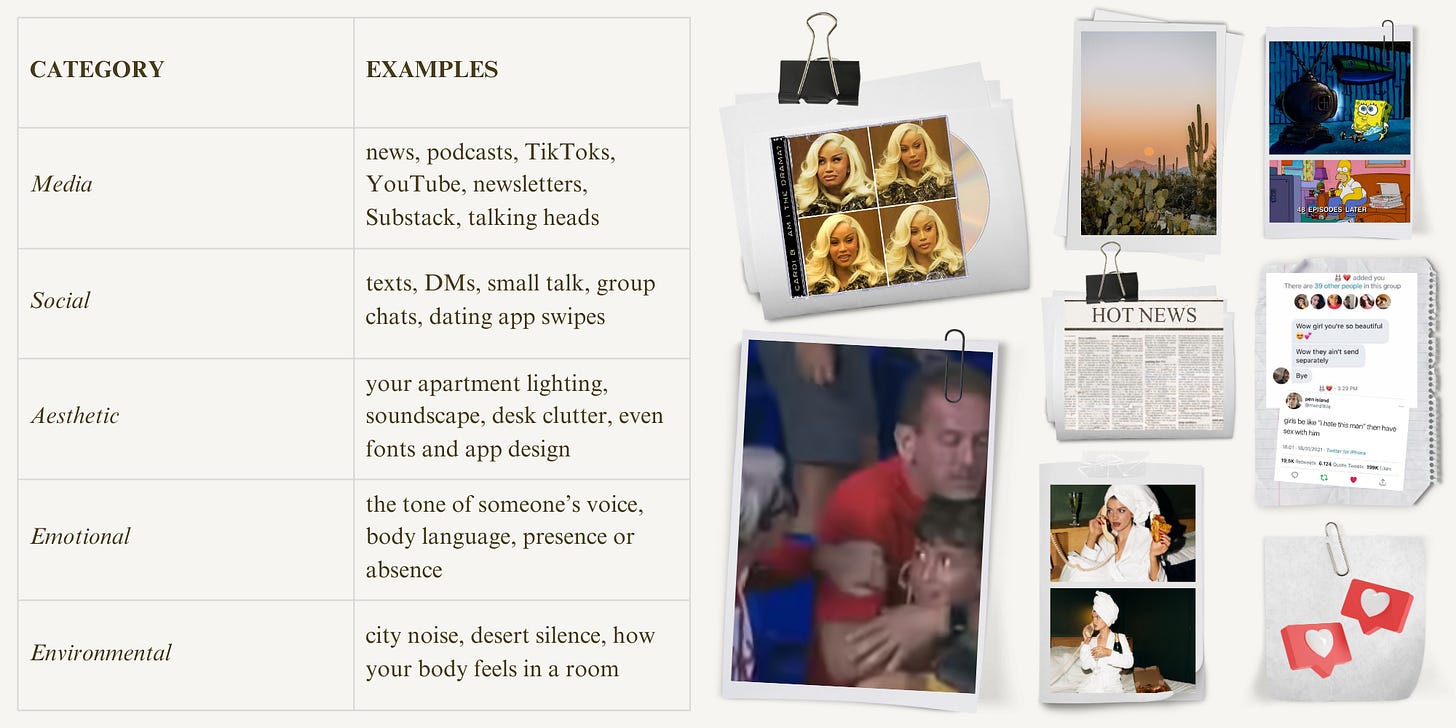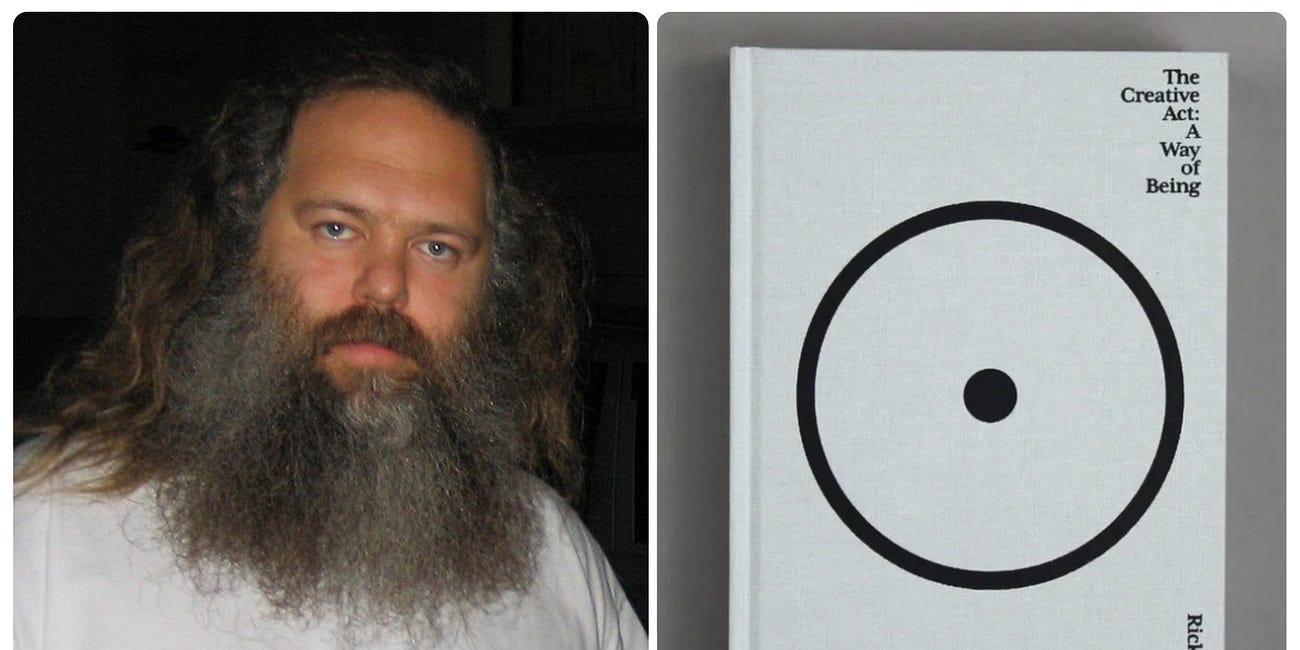[a wild bare guide] to self-sovereignty
This is the first in a new series of guides—small, focused drops that blend systems, reflection, and subtle structure for people building a more conscious, creative life. These guides are built to be returned to, not just read once. I’m keeping this one free because it sets the tone, but the rest will live behind a paywall. If this resonates, I hope you’ll consider subscribing to support more of it.
Paying readers also have access to all twelve weeks of THE DAILY 5 journaling framework, the full archive of paid-only essays, and all bite-sized art histories featuring my favorite creative muses. Thanks for supporting my work. x
The 5-minute daily ritual that changed how I think
THE DAILY 5 is a weekly journaling practice for people who want to understand themselves better—but don’t have hours to reflect every day. It’s structured, intentional, and grounded in real self-awar…
A 7-part exploration of sovereignty in the modern sense—authorship over your inputs, ideas, rhythms, and taste. Built for thinkers, creatives, and clear-minded people who want to remain intact in an ever-increasingly synthetic world.
01. Input Audit
the inputs shaping your thinking, and how to reclaim them with clarity and taste
02. Cognitive Sovereignty
why most “thought” is mimicry—and how mental models can become scaffolding for original ideas
03. Emotional Boundaries
discerning between true feeling and looping reaction; how to stay soft without leaking energy
04. Rhythm as Resistance
on time, tempo, and designing a nervous-system-friendly life that resists acceleration
05. Aesthetic Resistance
developing taste in a collapsing culture; building visual and sensory integrity
06. The System of You
the invisible structures shaping your identity—and how to design the ones you actually want
07. Prompts + Practices + Recommended Reading
reflection questions, input audits, and rituals for ongoing use + some of my favorite books on leveraging our thinking
WHAT I MEAN BY sovereignty is closer to authorship. It’s the ability to remain intact when everything around you is trying to fragment your attention, rewrite your values, and dull your taste. It’s not loud, and it’s not something you can show off. Most of the time, you only know you have it when you notice what isn’t pulling you off course.
Sovereignty begins in the small, everyday choices that most people never notice.
Choosing which voices you allow into your feed.
Choosing when to let silence hold more weight than reaction.
Choosing what rhythm your day belongs to, rather than letting it be scripted by alerts, deadlines, or someone else’s urgency.
This is agency in the modern sense: not the fantasy of total control, but the skill of directing attention, taste, time, and meaning toward something coherent.
When you zoom out, the aim of sovereignty is simple: to stay intact. To not be hollowed out by every trend, outrage cycle, or borrowed script. To carry your own tempo into a world that moves too fast for its own good.
Sovereignty is not about separation—it’s about holding shape. Thought that doesn’t collapse under pressure. Rhythm that doesn’t bend to noise. Values that aren’t confused with the loudest narrative in the room.
Take a moment to write down your thoughts:
Your inputs aren’t just content. They’re conditions.
MOST OF US GO THROUGH the day absorbing more than we realize—scrolling, skimming, overhearing, second-guessing, reacting. Every conversation, every notification, every pixel of a feed is information. And information doesn’t just inform. It accumulates. It lingers. It rewires.
The problem isn’t exposure. It’s volume. Saturation leaves no space for reflection, and without reflection, we mistake familiarity for truth. We start to echo what we’re surrounded by. Not because we agree—but because we’ve lost the energy to push against it.
The scariest thing about our inputs is how passive they feel. Most of what enters your head never knocks. It just slides in. A sentence here. A comment thread there. A phrase repeated enough times to feel like your own.
This is where sovereignty starts to dissolve: not in a single moment, but in the slow drip of unfiltered absorption.
When you choose what to read, who to listen to, what visuals you allow into your day—you’re not just filtering information. You’re shaping the architecture of your thinking.
Ease is not neutral. The most accessible information is rarely the most valuable. It’s just the most available.
So the first real act of sovereignty is noticing where your inputs are coming from—and whether you chose them, or they chose you.
This is your chance to re-architect your intake.
Grab a notebook or open a clean doc and create three columns:
Currently Consuming
No Longer Serving
Intentionally Adding
Go through these categories:
Visual inputs: What imagery do I scroll past 100x a day? What am I absorbing without noticing?
Narrative inputs: What stories do I keep hearing? Which ones repeat, distort, dramatize, sedate?
Conversational inputs: Who do I talk to that sharpens me? Who dulls me?
Ambient inputs: Is there enough silence? What do I hear when I’m not being spoken to?
This isn’t a detox. It’s an audit. You’re not trying to go offline—you’re trying to re-enter your life with taste.
Which inputs leave me sharper, calmer, more myself—and which leave me scattered, reactive, or uncertain?
Be specific. It’s usually not “all social media” or “all news.” It’s a few accounts, a few people, a few patterns you haven’t named yet.
THERE’S A DIFFERENCE BETWEEN processing information and actually thinking. Most of what passes for thought today is frictionless mimicry—a constant looping of reactions, fragments, and borrowed takes passed back and forth until no one can remember where the idea even started. This isn’t a moral failure. It’s a design flaw in the world we live in.
You don’t have to try to absorb other people’s thoughts. It happens automatically. Exposure becomes familiarity. Familiarity becomes belief. Belief becomes identity. By the time it’s embedded, you think it’s yours.
“Most people don’t think. They just rearrange their prejudices.” – William James
That’s what makes cognitive sovereignty such a strange thing to talk about. You don’t lose it all at once—you give it away in micro-decisions. In letting your inputs go unfiltered. In mistaking agreement for truth. In modeling your speech after whoever’s getting the most attention. In absorbing not just ideas, but tone, rhythm, certainty. You can start sounding intelligent without ever stopping to think.
Sovereignty here isn’t about being a contrarian. It’s about developing enough inner gravity that your thoughts don’t just drift into alignment with whatever you’re most surrounded by. It’s about resisting the impulse to echo. To please. To perform. And it’s about being able to hold tension—especially the kind that doesn’t resolve easily.
Real thought takes effort, which makes it increasingly rare. The world is optimized for quick reactions and instant opinions, not contemplation. But if you move too quickly through ideas, you end up repeating structures that don’t belong to you. You inherit entire mental architectures without realizing it—and once those are installed, everything you see will be shaped by them.
So thinking—actual thinking—requires interruption. Not just of outside noise, but of your own internal monologue. It asks for pauses. For friction. For the ability to sit with something ambiguous without scrambling to solve it. It’s not always comfortable. In fact, it’s usually inconvenient. That’s how you know it’s real.
The most sovereign thinkers aren’t always the loudest. They’re the ones whose inner frameworks can hold contradiction. The ones who ask real questions instead of just sharpening their answers. The ones who have built a relationship with their own mind that isn’t purely based on output.
I’VE WRITTEN ABOUT mental models a lot because they genuinely change the way I experience the world. I’m endlessly fascinated by how certain people—especially entrepreneurs, scientists, systems thinkers—seem to see differently. And how those ways of seeing end up shaping everything downstream: their decisions, their products, their leadership, their pace.
When you start noticing how someone like Elon Musk makes decisions, or how Richard Feynman approached knowledge, or how Richard Dawkins thinks about ideas as self-replicating memes—you realize these people aren’t just smart. They’re operating with a different map entirely.
And that’s what a mental model is. It’s not a hack. It’s not a clever thought experiment. It’s a lens that rearranges how you perceive the terrain. Once you have a strong one, you can’t unsee it. That clarity becomes addictive.
In previous essays, I’ve broken down some of the models that have stuck with me the most:
Mental Models for People Who Actually Want to Think
Useful Wrongness (Feynman, Ray Dalio)
The Alchemy of A Worldview (constructing mental models)
The Thinking Person’s Toolkit (exploring 50 different mental models)
How to Think Like The Masters (history’s most profound models)
These essays go much deeper than this guide can—but the essence is this:
IF YOU WANT TO THINK more clearly, start paying attention to the structure of your thoughts—not just the content. Do they come from observation, or from mimicry? Are they built to hold weight, or just to sound good online?
Models are scaffolding. They don’t replace reality. But they help you see its shape—and sometimes that’s enough to change everything.
You don’t need a full library of mental models to think well. But having a few helps. Not as identity markers or frameworks to flex, but as levers to pry open assumptions you didn’t realize you were living inside. If I could only share three with you, they’d be these:
First principles thinking strips everything down to what’s real and observable. Not what’s popular. Not what’s predicted. Just: what is undeniably true here, and what have I added on top of it?
Second-order thinking helps you stop reacting to what’s happening and start anticipating what’s likely to happen next. It’s a way of catching the ripple before it becomes a wave.
And a basic input/output loop will tell you everything you need to know. If your thoughts feel scattered, flat, or prepackaged—go upstream. Look at what you’ve been consuming. Ideas don’t appear out of nowhere. They reflect the conditions they were born in.
machine yearning
After I published my essay on self-pursuit last month, I started receiving lots of messages from people who wanted to know the practical mechanics of it all. I'd mentioned in passing that I use AI for daily journaling, calling it
But none of this matters without time. You cannot think in a rush. You cannot think in performance. You cannot think while optimizing for reaction.
What am I actually in contact with?
What idea, question, or experience am I sitting with long enough that it changes me—even just a little?
SOME PEOPLE THINK emotional boundaries are about being hard to reach. Like if you’re chill enough, unbothered enough, untouched by everything, you’ve somehow mastered yourself. But being “unbothered” is usually just another kind of shut-down.
This isn’t about walling off your emotional life. It’s about knowing what’s yours. What you’re actually feeling, and what’s been handed to you. What’s asking to be metabolized—and what’s just hanging around out of habit. Because if you don’t make space to notice, your nervous system becomes a catch-all for every signal that passes through: urgency, shame, stimulation, tension, ambient dread.
You can’t have sovereignty if your inner weather is being shaped by external forecasts.
Let’s be clear—emotional sovereignty isn’t about control. It’s not about always being calm, or never spiraling, or refusing to feel things deeply. It’s about knowing when your response is aligned with the present, and when you’re playing out an older script.
That means learning the difference between a clean emotion and a looping one.
Clean emotions arise from the situation at hand. You feel them, name them, let them move. Looping ones are recursive. They draw power from the past. They don’t close. They want to replay—not to be resolved, but to stay familiar.
A lot of people confuse their loops with their personality.
That’s where emotional sovereignty gets lost.
Signs you’ve been hijacked:
Your reaction is way louder than the moment calls for
You’re interpreting silence, not words
You feel the need to explain yourself over and over
You keep rehearsing conversations that already ended
You’re scanning for tone instead of listening for meaning
Sometimes it’s not that you’re being “too emotional.”
You’re just not sure which part of you the emotion belongs to.
Restraint is underrated. Not in a moral sense, but in a sensory one.
You don’t have to absorb everything you feel. You can observe it, name it, let it pass.
THERE’S A REASON EVERYTHING feels faster now—and it’s not just the technology. The entire shape of our world is biased toward acceleration. Faster decisions, faster consumption, faster pivots, faster takes. You’re expected to respond quickly, adjust seamlessly, adapt constantly. Even your “rest” is supposed to be productive. Even your leisure is supposed to be optimized.
But no one can think clearly, create honestly, or live well at that speed forever.
Eventually, the rhythm starts to override the content. You stop choosing what you’re doing and start letting the tempo decide for you.
That’s why rhythm isn’t a lifestyle choice. It’s a boundary.
MOST PEOPLE DON’T HAVE time. They have scheduling. They have blocks and tasks and notifications, but no rhythm. No organic movement through their day. No variation in texture or tempo.
Rhythm is different. Rhythm has memory. Rhythm is relational. It’s not just how you organize your hours—it’s how your nervous system relates to them. That’s why slowing down isn’t always restful—especially if you’re not doing it by choice.
Stillness under pressure is anxiety. Stillness with agency is power.
Most people are leaking energy before noon. Not because they’re lazy, but because their day is shaped like a funnel: wide open at the top, increasingly constrained as the noise accumulates. There’s no container. No anchoring rituals. No agreements with themselves about what matters.
If you don’t design your own rhythm, someone will assign you theirs.
That might look like:
A job that controls your mornings
A phone that sets your pace
A partner whose mood becomes your weather system
A world that punishes rest with guilt and rewards burnout with praise
Rhythm doesn’t have to mean strict routines. Some of the most sovereign people you’ll meet are the ones who’ve built flexible, quiet rituals that don’t require explanation:
A 10-minute walk before answering messages
A real breakfast at the kitchen table, no scrolling
Lighting a candle at dusk, even if you don’t know why
Playing the same playlist every Sunday while cleaning the house
Weekly silences—spaces on the calendar that aren’t “free,” they’re sacred
None of these are complicated, and that’s exactly why they work. They create edges in a day. Moments that remind you: this life is being lived by a person (me! you!)
15 unglamorous rituals that keep me sane
I've been thinking about the word "ritual" lately, how it carries this weight of ceremony and meaning that feels almost embarrassing to apply to something as mundane as going for a walk or making sur…
THIS MIGHT BE THE MOST subtle form of aesthetic resistance: Choosing when and how to move. Refusing to be rushed into thoughts you haven’t chosen or moods you didn’t consent to.
Rhythm protects clarity.
Pace protects perspective.
Where in your day does time feel expansive?
Where does it collapse?
What rituals bring you back into your own rhythm, even for a moment?
Taste as a way of seeing, filtering, and staying intact
AESTHETICS AREN’T JUST about what looks good. They’re about what feels right. What resonates with your nervous system. What signals to you—consciously or not—that something has been tended to. Chosen. Considered. Not thrown together by algorithmic suggestion or dictated by trend.
And yet, aesthetic degradation is everywhere. In how we dress. In what we scroll. In the design of our cities, feeds, UIs, homes. The dominant tone of the internet is visual noise. A little too much. A little too fast. A little too optimized for engagement and not enough for presence.
You feel it when your feed starts to blur. When every podcast cover looks the same. When every caption starts sounding like a brand manual for a startup that doesn’t exist yet. When you’re drawn toward things that “perform well” rather than things that move you.
Taste is the counterforce. It’s the filter. It’s how you remember what’s real to you.
Taste is the new intelligence.
Good taste isn’t about what you like. It’s about what you notice. It’s how you relate to color, proportion, pace, silence. It’s knowing the difference between something that holds energy and something that was engineered to steal it.
Developing your aesthetic lens is one of the most direct ways to restore agency. It gives you a language for when something is “off” before you can explain why. It helps you exit patterns that feel visually fine but are emotionally incoherent.
You don’t need credentials to have taste. You just need to pay attention—and be willing to trust your own response.
WE’RE LIVING THROUGH a collapse of visual discernment. But taste can’t be manufactured—and that’s precisely why it’s so powerful. The more refined your aesthetic sensibility becomes, the more immune you are to being pulled off-course by things that “look right” but feel wrong. Taste becomes a kind of internal compass. A pressure valve. A yes/no mechanism that operates below language.
What am I visually surrounded by that no longer feels alive?
What would it look like to tend to my aesthetic life without trying to impress anyone?
What used to inspire me that I’ve quietly stopped seeking out?
Make a list:
Sounds that recalibrate me
Textures that ground me
Environments that sharpen me
Visuals that expand me
Inputs that no longer serve me
THERE’S NO PERFECT EXIT from the chaos. No clean line between you and the world you’re trying to navigate. But sovereignty doesn’t ask for perfection. It asks for pattern recognition. Self-responsibility. The willingness to look at how you’re shaped—and then reshape what no longer fits.
The truth is, you already live inside systems. Your relationships, your social defaults, your productivity apps, your feed, your calendar, your inherited beliefs, your coping strategies. None of them are neutral. None of them came from nowhere. They were designed—by someone. And if you’re not the one designing them now, they’ll keep running on their own, shaped by frictionless algorithms and outdated scripts.
This guide isn’t an attempt to fix your life. It’s a reminder that you already have an architecture for it. Whether that architecture is serving you—that’s the real question. Whether your values have made it into your daily rhythm. Whether your inputs reflect your priorities. Whether your taste still feels like your own.
BECAUSE AT THE END of the day, sovereignty doesn’t live in grand declarations. It lives in how you spend your mornings. What you pay attention to when no one is watching. How you protect your own tempo. How you choose what to let in. What you refuse to echo. What you continue to build, even quietly, when the world is louder than ever.
And maybe most importantly—what kind of signal you become for others. Not by preaching, but by moving through the world with discernment, clarity, and rhythm that doesn’t need to justify itself.
You are the system.
Make it a beautiful one.
25 prompts for getting UNSTUCK
30 journaling prompts for September
Recommended reading:
Poor Charlie’s Almanack – Charlie Munger’s mental model canon
The Art of Thinking Clearly – Rolf Dobelli (cognitive biases, sharp and digestible)
The Great Mental Models Vol I – Shane Parrish (Farnam Street)
The Quark and the Jaguar – Murray Gell-Mann (complexity, emergence, physics of thinking)
Recommended listening:
Naval Ravikant’s interviews on leverage, decision trees, and knowledge compounding
Steve Jobs’ 2005 Stanford Commencement Speech (actually timeless)
Learning mental models isn’t about memorizing definitions—it’s about pressure-testing them in your own life. Models are tools, and you sharpen them by applying them to real decisions and patterns. So here’s a practice to make that real.
Pick one area of your life you’ve been thinking about lately:
Fitness
Love
Money
Work
Creative expression
Self-discipline
Then apply these 3 models to that area:
1. Inversion
“What would guarantee failure?”
Instead of asking what success looks like, flip it.
What are the obvious, recurring patterns that would destroy your progress here?
If it’s fitness: skipping sleep? all-or-nothing thinking? overtraining and quitting?
If it’s love: avoiding hard conversations? chasing unavailability? self-abandoning to appease?
Write down 3 things that would definitely sabotage this part of your life. Then… stop doing them.
2. Marginal Gains
“What tiny habit would compound over time?”
Forget overhauls. What’s the smallest action you could do consistently that would move the needle 1%?
For money: tracking expenses for 2 minutes a day
For fitness: 10 squats while your coffee brews
For creativity: 1 sentence written every morning
Name the micro-habit. Commit for 7 days. See what happens.
3. Leverage
“What’s the 20% input that drives 80% of the result?”
This is about identifying asymmetric returns. You’re looking for the thing that—once in place—makes everything else easier or irrelevant.
In work: automating one process that saves hours a week
In love: one boundary that protects your peace
In fitness: meal-prepping once so you stop Postmating daily
Ask: what’s the one change that buys me time, energy, or clarity?
You can revisit this exercise daily, weekly, monthly, or whenever you feel stuck.
This isn’t a guide you finish. It’s a reference point.
Come back when your inputs feel chaotic. When your mind’s loud. When you feel you’ve started outsourcing your instincts again.
The point isn’t to optimize everything, it’s to stay in contact with yourself.
Use what’s useful. Scrap the rest. (You’ll know the difference)
Next up in this series: decision frameworks, digital clarity, systems of taste, and how to build rituals that don’t feel like chores.
If you’re already a paid reader—thank you. If not, you can upgrade below to unlock the rest. Thank you for supporting my work, I am forever grateful. x
































